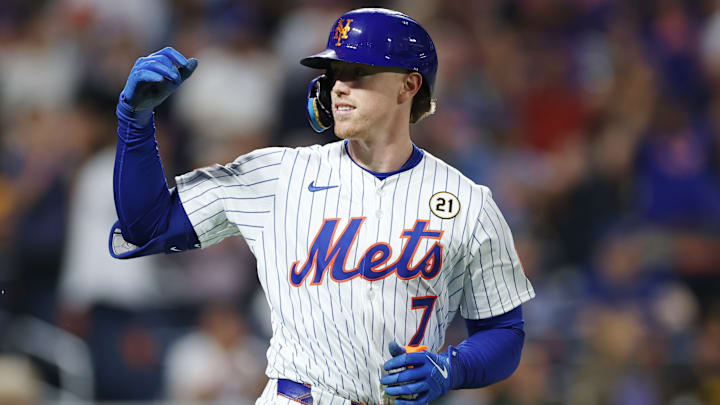For the first time in a while, third base feels settled in Queens. The New York Mets spent 2025 watching Brett Baty turn consistency into credibility, anchoring the lineup and calming the infield. His growth was evident in every strong throw across the diamond and every timely swing—the signs of a player who’s found his major league footing.
By season’s end, the question wasn’t whether Baty belonged—it was how soon the Mets would make it official. His improvement on both sides of the ball made third base look stable, even sustainable, for 2026. That reliability at the hot corner now gives the Mets freedom to focus their winter resources elsewhere, confident that one position no longer needs fixing.
Brett Baty has done enough to lock down the Mets third base job in 2026
Baty’s 2025 numbers might not make highlight reels, but they quietly laid the groundwork for a strong case at third base. Over 393 at-bats, he hit .254 with a .313 OBP, an 18-homer tally, and a 111 OPS+. On paper, it’s serviceable, not spectacular. However, late in the season, when the stakes were highest and the Mets needed stability, Baty elevated his impact at the plate and in the field, showing he could provide both reliable offense and steady defense in key moments.
From August 1 on, Baty hit .308 with a .370 OBP and an .866 OPS, asserting himself as the steady hand the Mets sorely needed. Meanwhile, Mark Vientos faltered both offensively and defensively, and Ronny Mauricio, though strong with the glove, struggled at the plate. When Baty got regular reps, he delivered in both aspects of the game, showing he can be a solid and dependable option at third base.
Brett Baty’s defense shows the Mets don’t need a top free-agent third baseman
Defensively, Baty has taken clear steps forward. Compared to Alex Bregman, one of the top free-agent third basemen this offseason, his 2025 numbers hold up. While Bregman’s OAA and DRS were 3 and 1 over 972.1 innings, Baty posted 4 and 2 over just 573 innings. With bench coach Kai Correa now working with infielders, Baty’s glove has room to grow even further, turning reliability into a quietly impressive strength.
With Baty ready to handle third base, the Mets can breathe easily and focus their resources on other areas of need this offseason. He proved last season that he can provide steady production both at the plate and in the field, and if anything goes sideways, the team has a built-in safety net. Sixth-ranked prospect Jacob Reimer is tearing up the minor leagues and could step up in the near future, giving the Mets flexibility while betting on Baty to anchor the hot corner.
Baty’s 2025 finish doesn’t just earn him the starting job; it reshapes the Mets’ approach to third base. They can enter 2026 confident in-house, save money, and focus on upgrades elsewhere, while their 6th-ranked prospect continues to rise in the minors. With his performance, the hot corner isn’t a question anymore; it’s his.
